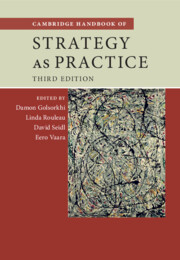Book contents
- Cambridge Handbook of Strategy as Practice
- Cambridge Handbook of Strategy as Practice
- Copyright page
- Contents
- Figures
- Tables
- Boxes
- Contributors
- Preface to the Third Edition
- Introduction: What Is Strategy as Practice?
- Part I Ontological and Epistemological Questions
- Part II Theoretical Resources: Social Theory
- Part III Theoretical Resources: Organization and Management Theories
- Part IV Methodological Resources
- Part V Substantive Topic Areas
- Chapter 33 Strategic Planning as Practice
- Chapter 34 Meetings and Workshops as Strategy Practices
- Chapter 35 The Role of Materiality in the Practice of Strategy Revisited
- Chapter 36 Participation in Strategy Work
- Chapter 37 Open Strategy as a New Form of Strategizing
- Chapter 38 The Role of Emotions in Strategizing
- Chapter 39 Temporality in Strategy as Practice
- Chapter 40 Multimodality in Strategy-as-Practice Research
- Chapter 41 The Role of Play in Strategizing
- Chapter 42 Feminist Perspectives on Doing Strategy-as-Practice Research
- Chapter 43 At the Interface of Extreme Contexts and Strategy as Practice
- Index
- References
Chapter 43 - At the Interface of Extreme Contexts and Strategy as Practice
from Part V - Substantive Topic Areas
Published online by Cambridge University Press: 11 March 2025
- Cambridge Handbook of Strategy as Practice
- Cambridge Handbook of Strategy as Practice
- Copyright page
- Contents
- Figures
- Tables
- Boxes
- Contributors
- Preface to the Third Edition
- Introduction: What Is Strategy as Practice?
- Part I Ontological and Epistemological Questions
- Part II Theoretical Resources: Social Theory
- Part III Theoretical Resources: Organization and Management Theories
- Part IV Methodological Resources
- Part V Substantive Topic Areas
- Chapter 33 Strategic Planning as Practice
- Chapter 34 Meetings and Workshops as Strategy Practices
- Chapter 35 The Role of Materiality in the Practice of Strategy Revisited
- Chapter 36 Participation in Strategy Work
- Chapter 37 Open Strategy as a New Form of Strategizing
- Chapter 38 The Role of Emotions in Strategizing
- Chapter 39 Temporality in Strategy as Practice
- Chapter 40 Multimodality in Strategy-as-Practice Research
- Chapter 41 The Role of Play in Strategizing
- Chapter 42 Feminist Perspectives on Doing Strategy-as-Practice Research
- Chapter 43 At the Interface of Extreme Contexts and Strategy as Practice
- Index
- References
Summary
Markus Hällgren, Oscar Rantatalo and Ola Lindberg examine the interface between research on extreme contexts and strategy as practice research. The authors argue that combining these two bodies of literature can help management and organization researchers to develop more impactful research. They start by discussing what an extreme context is, followed by an overview of how strategizing plays out in risky, emergency, disruptive and surprising contexts. Then, the authors provide an empirical vignette from their own research as an example of strategy work in a risky setting. This example uses incident command organizing to perform strategic work during extreme situations. The case study illustrates how strategic change entails a dynamic and political process during which actors within the same practice may act with different objectives. While the authors show that excellent work has already been done at the interface of extreme contexts and strategy as practice research, they suggest future research avenues that would allow reinforcing the bridges between these two areas of research.
- Type
- Chapter
- Information
- Cambridge Handbook of Strategy as Practice , pp. 773 - 788Publisher: Cambridge University PressPrint publication year: 2025

